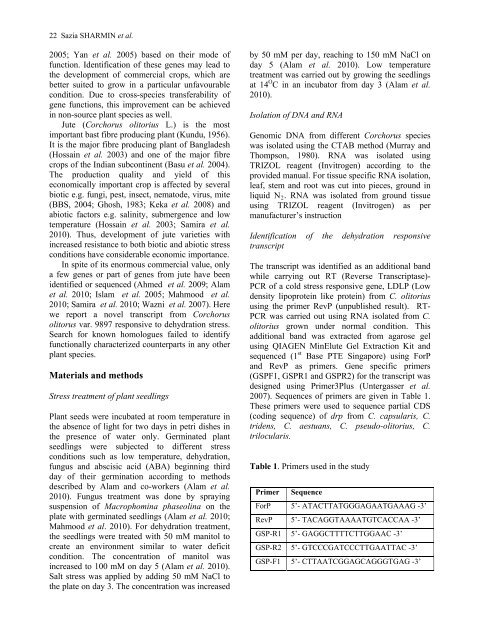Vol 9 No1 - Journal of Cell and Molecular Biology - Haliç Üniversitesi
Vol 9 No1 - Journal of Cell and Molecular Biology - Haliç Üniversitesi
Vol 9 No1 - Journal of Cell and Molecular Biology - Haliç Üniversitesi
Create successful ePaper yourself
Turn your PDF publications into a flip-book with our unique Google optimized e-Paper software.
22 Sazia SHARMIN et al.<br />
2005; Yan et al. 2005) based on their mode <strong>of</strong><br />
function. Identification <strong>of</strong> these genes may lead to<br />
the development <strong>of</strong> commercial crops, which are<br />
better suited to grow in a particular unfavourable<br />
condition. Due to cross-species transferability <strong>of</strong><br />
gene functions, this improvement can be achieved<br />
in non-source plant species as well.<br />
Jute (Corchorus olitorius L.) is the most<br />
important bast fibre producing plant (Kundu, 1956).<br />
It is the major fibre producing plant <strong>of</strong> Bangladesh<br />
(Hossain et al. 2003) <strong>and</strong> one <strong>of</strong> the major fibre<br />
crops <strong>of</strong> the Indian subcontinent (Basu et al. 2004).<br />
The production quality <strong>and</strong> yield <strong>of</strong> this<br />
economically important crop is affected by several<br />
biotic e.g. fungi, pest, insect, nematode, virus, mite<br />
(BBS, 2004; Ghosh, 1983; Keka et al. 2008) <strong>and</strong><br />
abiotic factors e.g. salinity, submergence <strong>and</strong> low<br />
temperature (Hossain et al. 2003; Samira et al.<br />
2010). Thus, development <strong>of</strong> jute varieties with<br />
increased resistance to both biotic <strong>and</strong> abiotic stress<br />
conditions have considerable economic importance.<br />
In spite <strong>of</strong> its enormous commercial value, only<br />
a few genes or part <strong>of</strong> genes from jute have been<br />
identified or sequenced (Ahmed et al. 2009; Alam<br />
et al. 2010; Islam et al. 2005; Mahmood et al.<br />
2010; Samira et al. 2010; Wazni et al. 2007). Here<br />
we report a novel transcript from Corchorus<br />
olitorus var. 9897 responsive to dehydration stress.<br />
Search for known homologues failed to identify<br />
functionally characterized counterparts in any other<br />
plant species.<br />
Materials <strong>and</strong> methods<br />
Stress treatment <strong>of</strong> plant seedlings<br />
Plant seeds were incubated at room temperature in<br />
the absence <strong>of</strong> light for two days in petri dishes in<br />
the presence <strong>of</strong> water only. Germinated plant<br />
seedlings were subjected to different stress<br />
conditions such as low temperature, dehydration,<br />
fungus <strong>and</strong> abscisic acid (ABA) beginning third<br />
day <strong>of</strong> their germination according to methods<br />
described by Alam <strong>and</strong> co-workers (Alam et al.<br />
2010). Fungus treatment was done by spraying<br />
suspension <strong>of</strong> Macrophomina phaseolina on the<br />
plate with germinated seedlings (Alam et al. 2010;<br />
Mahmood et al. 2010). For dehydration treatment,<br />
the seedlings were treated with 50 mM manitol to<br />
create an environment similar to water deficit<br />
condition. The concentration <strong>of</strong> manitol was<br />
increased to 100 mM on day 5 (Alam et al. 2010).<br />
Salt stress was applied by adding 50 mM NaCl to<br />
the plate on day 3. The concentration was increased<br />
by 50 mM per day, reaching to 150 mM NaCl on<br />
day 5 (Alam et al. 2010). Low temperature<br />
treatment was carried out by growing the seedlings<br />
at 14 O C in an incubator from day 3 (Alam et al.<br />
2010).<br />
Isolation <strong>of</strong> DNA <strong>and</strong> RNA<br />
Genomic DNA from different Corchorus species<br />
was isolated using the CTAB method (Murray <strong>and</strong><br />
Thompson, 1980). RNA was isolated using<br />
TRIZOL reagent (Invitrogen) according to the<br />
provided manual. For tissue specific RNA isolation,<br />
leaf, stem <strong>and</strong> root was cut into pieces, ground in<br />
liquid N2. RNA was isolated from ground tissue<br />
using TRIZOL reagent (Invitrogen) as per<br />
manufacturer’s instruction<br />
Identification <strong>of</strong> the dehydration responsive<br />
transcript<br />
The transcript was identified as an additional b<strong>and</strong><br />
while carrying out RT (Reverse Transcriptase)-<br />
PCR <strong>of</strong> a cold stress responsive gene, LDLP (Low<br />
density lipoprotein like protein) from C. olitorius<br />
using the primer RevP (unpublished result). RT-<br />
PCR was carried out using RNA isolated from C.<br />
olitorius grown under normal condition. This<br />
additional b<strong>and</strong> was extracted from agarose gel<br />
using QIAGEN MinElute Gel Extraction Kit <strong>and</strong><br />
sequenced (1 st Base PTE Singapore) using ForP<br />
<strong>and</strong> RevP as primers. Gene specific primers<br />
(GSPF1, GSPR1 <strong>and</strong> GSPR2) for the transcript was<br />
designed using Primer3Plus (Untergasser et al.<br />
2007). Sequences <strong>of</strong> primers are given in Table 1.<br />
These primers were used to sequence partial CDS<br />
(coding sequence) <strong>of</strong> drp from C. capsularis, C.<br />
tridens, C. aestuans, C. pseudo-olitorius, C.<br />
trilocularis.<br />
Table 1. Primers used in the study<br />
Primer Sequence<br />
ForP 5’- ATACTTATGGGAGAATGAAAG -3’<br />
RevP 5’- TACAGGTAAAATGTCACCAA -3’<br />
GSP-R1 5’- GAGGCTTTTCTTGGAAC -3’<br />
GSP-R2 5’- GTCCCGATCCCTTGAATTAC -3’<br />
GSP-F1 5’- CTTAATCGGAGCAGGGTGAG -3’

















